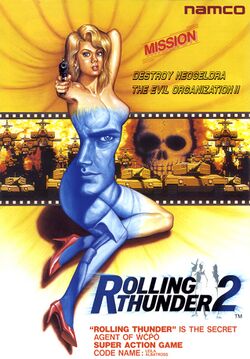
| Rolling Thunder 2 | |
|---|---|
| Developer(s) | Namco |
| Publisher(s) | Namco |
| Year released | 1990 |
| System(s) | Arcade, Sega Genesis, Wii |
| Preceded by | Rolling Thunder |
| Followed by | Rolling Thunder 3 |
| Series | Rolling Thunder, Arcade Archives |
| Japanese title | ローリングサンダー2 |
|---|---|
| Genre(s) | Run and gun |
| Players | 1-2 |
| Modes | Single player, Multiplayer |
| Rating(s) |
| Arcade Archives Rolling Thunder 2 | |
|---|---|
| Developer(s) | Namco |
| Publisher(s) | Hamster Corporation |
| Year released | 2023 |
| System(s) | Nintendo Switch, PlayStation 4 |
| Rating(s) | |
Rolling Thunder 2 is a run and gun arcade game, that was released by Namco in 1990. It runs upon Namco System 2 hardware and as the name suggests, it is the sequel to Rolling Thunder, which was released four years earlier. As with its predecessor, it used a Yamaha YM-2151 FM sound chip for its songs, but it used a C140 custom sound chip for its sound effects (as opposed to a PSG and a DAC).
Introduction[edit]
The Geldra organization, who are now known as Neo-Geldra and led by a new leader named Gimdo, and thought to have been destroyed at the end of the original Rolling Thunder, has returned, and are destroying several of the world's satellites in outer space. As with the original game, the players must take control of a member of Interpol's fictitious "Rolling Thunder" task force; two players can now play this game simultaneously, while a single player now has a choice: between former damsel-in-distress Leila Blitz (1-UP) or the returning hero Albatross (2-UP). Apart from their different visual appearances (including different hand-guns), both the characters play exactly the same (much like Yūichirō Tomari and Sunday Chin, from Namco's own Ordyne - which was released two years earlier, and also ran on Namco System 2 hardware). The graphics are noticeably improved from the original game (given that it is 16-bit, as opposed to 8-bit), and have a decidedly more futuristic look to go along with the game's modern setting; and the common enemy characters of "Maskers", (which were previously designed to look like hooded terrorists) are now cyborgs. The game also has more varied stage designs - with the first four stages taking place in a seaside resort in the US state of Florida and the last four stages in a pyramid in Egypt (both the locations are actually camouflaged Neo-Geldra bases, if you do not know).
-
Title screen.
-
Attract opening cutscene.
-
First stage of the game.
-
Japanese Sega Genesis cover art.
-
American Sega Genesis cover art.





